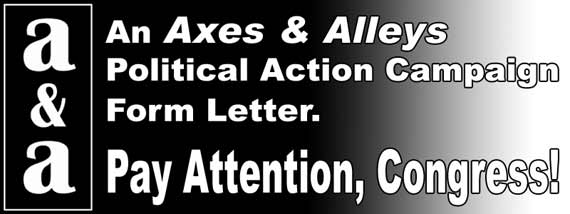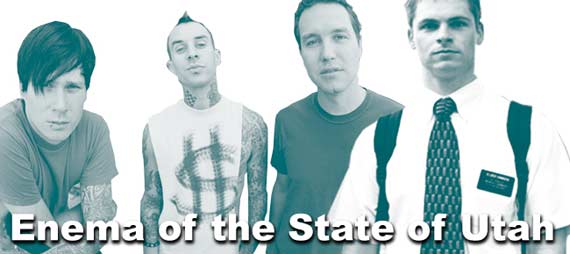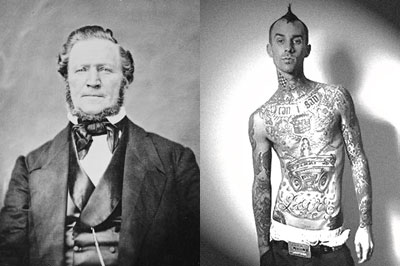
Category Archives: Jeremy Rosen
More Attention for Congress to Pay
Our previous post asked for you to help our economy and solve the looming oil crisis by writing your representatives and senators in Congress and requesting that they provide both the esteemed Mr. Birdseye and myself with Letters of Marque so that we may equip privateers.
Many of you turn out to be lazy, so here are two additional options.
1. Download a PDF copy of the letter HERE, print it, and mail it to your congressperson;
or
2. open it, and email it to your congressperson HERE and HERE.
Pay Attention, Congress!
An Open Letter to Representative Carolyn Maloney, Senator Hillary Clinton, and Senator Chuck Schumer
To Whom it May Concern,
I am one of your constituents in Astoria, NY and am writing to you today to seek your assistance in obtaining a Letter of Marque. Congress is, of course, authorized to issue such documents to private citizens under Article I, Section 8 of the Constitution of the United States.
As you are no doubt aware, rising oil prices are a major economic problem in America today. Not only do consumers pay more at the pump, but manufacturing and transportation costs have increased as well, driving up the cost of goods and services even for those who, like me, choose not to drive automobiles.
With a Letter of Marque, it would be possible for me to equip several Privateers which could operate in international waters and sea lanes. As modern supertankers have only a small crew, their capture would be relatively easy. The oil shipments would be delivered to major U.S. ports and the oil distributed inexpensively to refineries who would then pass the savings on to consumers. Oil prices would drop and that would help the economy.
Venezuelan and Middle Eastern tankers would make easy prey and the attitudes of Presidents Hugo Chavez, Mahmoud Ahmadinejad, Bashar Al-Assad, and Omar Hasan Ahmad al-Bashir already represent a situation of undeclared hostilities between their nations and ours. The United States and its people would greatly benefit from this captured oil. In the latter’s case, decreased oil revenues would harm Sudan’s ability to continue instigating a humanitarian crisis, gaining you even more votes from your constituents.
Petroleum is a non-renewable resource and some fear that we are approaching a “peak-oil” crisis where demand outstrips supply. Geologists and oil companies are constantly looking for new sources of oil, and Privateers would enable the U.S. to access an entirely new, inexpensive source of oil: foreign supertankers. There is no resulting fear of rising oil prices from an OPEC embargo because my Privateers would be capturing oil from the same countries for free.
This would not cause any diplomatic issues, as all my Privateers would fly an independent, skull-and-crossbones flag and no effort would be spared to ensure that the foreign tanker crews would be unharmed and repatriated as quickly as possible. Captured tankers would be given to Norway and other friendly oil-producing nations in exchange for price breaks on the purchase of oil.
With Congressional authorization and a duly issued Letter of Marque, I assure you that my Privateers would prove a great aid to the United States’ economy. As gasoline prices are expected to rise above the four dollar mark this summer, how could you possibly say no to Privateers?
Thank you, and I look forward to hearing from you soon.
Scott Birdseye and Jeremy Rosen
Astoria, NY

URGENT ACTION NEEDED NOW
Dear Congress-Person,
I am tired of paying too much for gasoline and angry that rising fuel prices drive up the manufacturing and transportation costs of the goods I purchase. My wallet and/or pocketbook can’t take a beating like this any longer!
Therefore, I urge you to grant Letters of Marque to American sailors, such as Captains Birdseye and Rosen, so that they can attack and seize foreign oil tankers on the high seas.
Please do this soon!
Privateers will strengthen our economy and allow hardworking families to put food on the table and to pay for healthcare for their children. If you do not grant Letters of Marque to American Privateer Captains, then I will be forced to vote for the challenger in the next election.
The people must be heard and Congress must act NOW to protect America’s economy.
Sincerely and Patriotically,
- (date: )
- Name:
- Address:
- Address:
- City:
- State:
- Zip Code:
- District:
Enema of the State of Utah

Why Mormonism is Not the Least Bit Like Blink-182. At All.
Professors Robert Burg and Dr. David Louzecky of the University of Wisconsin, Sheboygan, published a paper in this month’s History entitled “Enema of the State of Utah” in which they purport to lay bare the deep connections between The Church of Jesus Christ of Latter Day Saints and the now-defunct pop-punk band Blink-182. This preposterous position is indefensible and ridiculous.
In their introduction, the “professors” state that “the connections between the Restoration movement in 19th Century America and the late-90s emergence of the pop-punk phenomenon are obvious.” If any such connections were so obvious Dr. Louzecky (who obviously penned this scabrous portion of the paper), why didn’t anyone point this out earlier?
They go on to outline the various groups struggling for existence during the Restoration and compare this state of affairs with that record labels faced in the 1990s in attempting to “increase sales by meeting the perceived or manufactured demand for pop-punk music by offering up dozens of such instrumental groups to consumers.”
One might as well compare any group of things struggling for supremacy to any other. If we’re to play so loose with logic, the pop-punk era also bears a striking, whiz bang similarity American politics immediately preceding the Civil War, the struggle for control of the Muslim world in the 7th Century, and the Warring States period of Chinese history. In that case MxPx must be pretty damn similar to the Wei, right? Wrong.
In order to bolster these specious claims, Burg and Louzecky point out that Blink-182 and Mormonism were the “sole major successes of either movement.” This is patently false. Mormonism is only arguably a member of the Restoration movement as its initial history involves little time spent in the influential East of the United States and the promulgation of a completely new testament, something virtually unheard of amongst other Restoration congregations.
By contrast, Blink-182 was almost immediately at the forefront of the pop-punk in the late-90s, inciting the release of other acts such as Good Charlotte and Sum 41, but followed in the footsteps of groundbreakers Green Day and The Offspring. Some would even produce lacklustre punk pioneers The Ramones at starting end of pop-punk history.
In response to a referee’s critique similar to this one, Professor Burg points out that Mormonism also had hangers on in the form of the Churches of Christ and the Disciples of Christ as well as antecedents in the Anabaptists. This immediately disproves the previous point as both churches exist today with memberships near three million worldwide. While the Anabaptists no longer exist, neither do The Ramones. I’m still outraged that such sloppy research and thinking made its way through the initial review process of a major publication.
Taking this preposterousness further, the good “professors” compare the physical appearance of Blink-182 drummer Travis Barker to that of Latter Day Saint second-stringer Brigham Young. Take a look for yourself.
Professors Robert Burg and Dr. David Louzecky of the University of Wisconsin, Sheboygan, published a paper in this month’s History entitled “Enema of the State of Utah” in which they purport to lay bare the deep connections between The Church of Jesus Christ of Latter Day Saints and the now-defunct pop-punk band Blink-182. This preposterous position is indefensible and ridiculous.
In their introduction, the “professors” state that “the connections between the Restoration movement in 19th Century America and the late-90s emergence of the pop-punk phenomenon are obvious.” If any such connections were so obvious Dr. Louzecky (who obviously penned this scabrous portion of the paper), why didn’t anyone point this out earlier?
They go on to outline the various groups struggling for existence during the Restoration and compare this state of affairs with that record labels faced in the 1990s in attempting to “increase sales by meeting the perceived or manufactured demand for pop-punk music by offering up dozens of such instrumental groups to consumers.”
One might as well compare any group of things struggling for supremacy to any other. If we’re to play so loose with logic, the pop-punk era also bears a striking, whiz bang similarity American politics immediately preceding the Civil War, the struggle for control of the Muslim world in the 7th Century, and the Warring States period of Chinese history. In that case MxPx must be pretty damn similar to the Wei, right? Wrong.
In order to bolster these specious claims, Burg and Louzecky point out that Blink-182 and Mormonism were the “sole major successes of either movement.” This is patently false. Mormonism is only arguably a member of the Restoration movement as its initial history involves little time spent in the influential East of the United States and the promulgation of a completely new testament, something virtually unheard of amongst other Restoration congregations.
By contrast, Blink-182 was almost immediately at the forefront of the pop-punk in the late-90s, inciting the release of other acts such as Good Charlotte and Sum 41, but followed in the footsteps of groundbreakers Green Day and The Offspring. Some would even produce lacklustre punk pioneers The Ramones at starting end of pop-punk history.
In response to a referee’s critique similar to this one, Professor Burg points out that Mormonism also had hangers on in the form of the Churches of Christ and the Disciples of Christ as well as antecedents in the Anabaptists. This immediately disproves the previous point as both churches exist today with memberships near three million worldwide. While the Anabaptists no longer exist, neither do The Ramones. I’m still outraged that such sloppy research and thinking made its way through the initial review process of a major publication.
Taking this preposterousness further, the good “professors” compare the physical appearance of Blink-182 drummer Travis Barker to that of Latter Day Saint second-stringer Brigham Young. Take a look for yourself.

Clearly they’re both unattractive, though with a quite-surprising glint of intelligence in their eyes. However, the similarity ends there. For instance, Brigham Young wears clothes. Travis Barker can’t even be bothered to wear a belt.
Of course, the pair have left their most disgusting and mendacious pronouncement buried in an unassuming paragraph at the end of the paper on production values and land acquisition inspired by God. It is well-known that one of the tenets of the Latter Day Saints was the revelation of the Book of Mormon to Joseph Smith by the Angel Moroni.
In what is clearly a fiction created by Burg, it is unconvincingly shown that the angel and Enema of the State producer Jerry Finn share “remarkable and definite similarities.” These similarities include the fact that Moroni was a “record producer” because he came up with golden tablets inscribed with writing. How far can you stretch the truth, really?
You can find out by reading “Enema of the State of Utah,” which has already and unfortunately sparked discussion nationwide. Water cooler talk, local television news broadcasts, even editorials in free, weekly rags are expounding on the paper. One would hope such discussion casts a cold eye on the claims of Burg and Louzecky. Even the motivations of the two men are suspect, as I leave you with this statement from a KKBC-Kalisotta Public Radio interview with Louzecky.
“Hopefully the paper’s publication will bring in some big donors so we can get one of those nice, self-serve pop fountains in the Café.”
By Art Gomez, Associate Professor of Paramycology at the Pendergast Institute. Mr. Gomez is Chairman of the U.S. Thinking Committee, Vice-Admiral of the Civilian Naval Corps and a member of the American Historical Association. While born under the sign of Aries, he does not believe in or espouse astrology of any kind.
The Historigon: Fabuly 2007

This Month in History:
2006 AD: Robert Mugabe, President of Zimbabwe, plans to spend $4 million to build a museum dedicated to his underpants, but later decides to build a museum about everything Robert Mugabe instead.
2000 AD: After months of research, a successful formula is developed, allowing Wow™ detergent to leave colours 20% brighter.
1971 AD: The first video game, Immobile Square, is released to mixed reviews.
1944 AD: Scientists at Los Alamos National Laboratory are disappointed to discover that radiation exposure causes only crippling illness, ending the US Army’s Super-Soldier project.
1904 AD: Albert Einstein devises a clever way of moving up from 3rd Class patent clerk to 2nd Class patent clerk, thus getting a modest increase in salary.
1809 AD: Washtub technology is advanced by Hubert Smyles of Tennessee, who attaches a primitive splash guard to his tub.
1798 AD: Carthage, NY founded by Hannibal Johnson.
1783 AD: Captain Cook discovers the aptly-named June 3rd Island.
1353 AD: Noted Muslim traveler Ibn Battuta publishes what is regarded as a prototype for this very column, The Allah is Great Prism of Past Events.
1010 AD: Never one to be upstaged by Canute, King Edfald of Mercia orders his archers to shoot up at the Moon for a while.
814 AD: In a dispute over iconoclasm Nicephorus, Patriarch of Constantinople, excommunicates Emperor Leo V the Armenian. Leo responds by smashing an icon of Saint Basil the Great over Nicephorus’ head.
708 AD: Duke Drogo of Champagne dies after being knocked unconscious in one of the region’s first attempts at carbonating its famous wine. Innovation in this area is stifled for another 800 years as a result.
538 AD: Justinian issues the Edict of Sardinia, declaring that the Empire should slowly collapse over the next thousand years.
14 AD: Gaius Julius Caesar Octavianus, Caesar Augustus to his friends, realizes during a severe bout of diarrhea that he should probably have his grandson Agrippa murdered.
100 BC: Due to an accidental mistranslation, the author of 1 and 2 Maccabees unknowingly ascribes the exploits of the extremely lost Celtic clan MacCabe to a local Judean family.
456 BC: Athenian student Daramenaxos suggests adding a new element: Mud. Others explain that mud is just a combination of the known elements Earth and Water.
600 BC: An insane traveler from Africa arrives in Greece mumbling fantastic stories about talking animals doing nasty things to each other. Aesop writes them down and cleans them up a bit.
1258 BC: An accidental confluence of sea turtles in the Caribbean, if viewed from the air, spells out the first three items on the menu of McClatchy’s Fried House in Plenary, AL.
1958 AD. If viewed from the shore it spells nothing.
2944 BC: Yup, the Chinese record another comet appearing in the sky.
6000 BC: New Guinean highlander Rut discovers an exciting new recipe for taro dip. Later at the dinner party everyone is wowed.
8122 BC: The forebears of Jericho figure out how to make fake rocks and then stack them to create leaky homes and a wall. The latter falls down at a rather inopportune time about 2500 years later.
11,001 BC: Humans arrive in what will become Argentina, but are too tired to leave.
16,000 BC: Thanks to the warming of the Earth and the end of the most recent Ice Age, Liffdon is pleased to find his hovel is now a hundred paces closer to the water supply.
853, 000 BC: Nugar and Fipo discover that badger tastes much better than aardvark.
